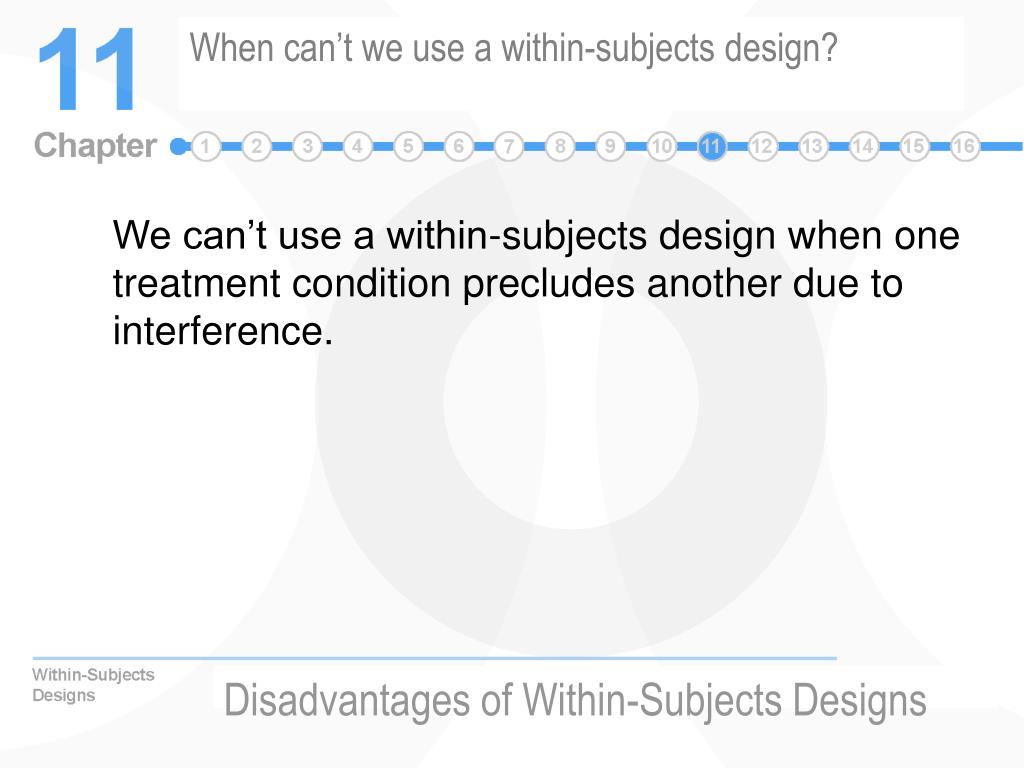Table Of Content

If you test two variables, each level of one independent variable is combined with each level of the other independent variable to create different conditions. The opposite of a within-subjects design is a between-subjects design, where each participant only experiences one condition, and different treatment groups are compared. Bruce Moseley and his colleagues conducted a study on the effectiveness of two arthroscopic surgery procedures for osteoarthritis of the knee (Moseley et al., 2002). The control participants in this study were prepped for surgery, received a tranquilizer, and even received three small incisions in their knees.
Simultaneous Within-Subjects Designs
A within-subjects design should not be used if researchers are concerned about the potential interferences of practice effects. The primary goal of a within-subjects design is to determine if one treatment condition is more effective than another. Finally, performance on subsequent tests can also be affected by practice effects. Taking part in different levels of the treatment or taking the measurement tests several times might help the participants become more skilled. A within-subjects design can be a good option if participants or resources are limited.
Practice Effects
Between-subjects designs usually have a control group (e.g., no treatment) and an experimental group, or multiple groups that differ on a variable (e.g., gender, ethnicity, test score etc). In a no-treatment control condition, participants receive no treatment whatsoever. A placebo is a simulated treatment that lacks any active ingredient or element that should make it effective, and a placebo effect is a positive effect of such a treatment. Many folk remedies that seem to work—such as eating chicken soup for a cold or placing soap under the bedsheets to stop nighttime leg cramps—are probably nothing more than placebos.
What is within-subjects study design?
Counterbalancing is sometimes more convenient for researchers because an even portion of the sample undergoes each sequence of conditions selected by researchers. Each treatment ideally appears equally often in each position (e.g., third) of the sequence. Although the within-subjects design is a great choice for many types of experiments, it doesn't fit all of them. For those it does fit, there are also limitations that researchers should be aware of to improve the design of their study.
Degree Type
Acute stress impacts reaction times in older but not in young adults in a flanker task Scientific Reports - Nature.com
Acute stress impacts reaction times in older but not in young adults in a flanker task Scientific Reports.
Posted: Tue, 17 Oct 2023 07:00:00 GMT [source]
To randomise treatment order, the order of the short stories is completely randomised between participants using a computer program. Every possible sequence can be presented to participants across the group, but in complete randomisation, you can’t control how often each sequence is used in the participant group. To help you better understand how between-subjects design compares to within-subjects design, let's take a look at the pros and cons of the former. Although every experiment should be designed according to its own unique set of criteria, below are the basic steps involved in using a within-subjects design. Understanding the options available to you is the first step in choosing the right design.
The Experimental Group in Psychology Experiments - Verywell Mind
The Experimental Group in Psychology Experiments.
Posted: Sat, 04 Nov 2023 07:00:00 GMT [source]
It is also referred to as repeated measures design or crossover design since researchers compare aspects of the same participants in varied conditions. In a within subject design, unlike a between subjects design, every single participant is subjected to every single treatment, including the control. There are many time-related threats to internal validity that only apply to within-subjects design because it’s hard to control the effects of time on the outcomes of the study. In experiments, a different independent variable treatment or manipulation is used in each condition to assess whether there is a cause-and-effect relationship with a dependent variable. One is to include a placebo control condition, in which participants receive a placebo that looks much like the treatment but lacks the active ingredient or element thought to be responsible for the treatment’s effectiveness.

The within-subjects design is the equivalent of one between-subjects design (individual participants are offered a singular condition). The word “within” in within-subjects design refers to the fact that the comparisons made are within the same subject or participant rather than between different groups of participants. Alternatively, the practice effect might mean that they are more confident and accomplished after the first condition, simply because the experience has made them more confident about taking tests. As a result, for many experiments, a counterbalance design, where the order of treatments is varied, is preferred, but this is not always possible.
Carryover effects
With counterbalancing, participants are assigned to orders randomly, using the techniques we have already discussed. Thus random assignment plays an important role in within-subjects designs just as in between-subjects designs. Here, instead of randomly assigning to conditions, they are randomly assigned to different orders of conditions. In fact, it can safely be said that if a study does not involve random assignment in one form or another, it is not an experiment. Between-subjects design is generally more suitable for studying between-subjects differences, such as the effects of different treatments or the influence of individual characteristics on a response.
Time
User research can be between-subjects or within-subjects (or both), depending on whether each participant is exposed to only one condition or to all conditions that are varied within a study. To detect a statistically significant difference between two conditions, you’ll often need a fairly large number of a data points (often above 40) in each condition. If you have a within-subject design, each participant will provide a data point for each level of the independent variable. For our car-rental study, 40 participants will provide data points for both sites. But if the study is between-subjects you will need twice as many to get the same number of data points.
She is currently studying for a Master's Degree in Counseling for Mental Health and Wellness in September 2023. The Within Design team was tasked with designing this incredible 5,554 sf custom home by CW Signature Homes in the gated enclave of Horseman’s Valley in Rancho Santa Fe. After a person has completed a series of tasks on a car-rental site, they are more knowledgeable about the domain than she was before. For example, they may now know that car-rental sites charge an extra fee for drivers under 21, or what a collision-damage waiver is. That knowledge will likely help them become more efficient on a second car-rental site, even though that second site may be very different from the first.
But if the study is between-subjects, the happy participant will only interact with one site and may affect the final results. You’ll have to make sure you get a similar happy participant in the other group to counteract her effects. Perhaps the most important advantage of within-subject designs is that they make it less likely that a real difference that exists between your conditions will stay undetected or be covered by random noise.
For example, if a researcher is studying the effect of a treatment on anxiety, they could use a within-subjects design and randomly assign the order in which the treatment and control conditions are presented to each participant. This helps to control for potential order effects and reduces the risk of systematic bias. In a between-subjects design, randomization helps to control for extraneous variables that may differ between the groups, such as age, gender, and background. By randomly assigning participants to different groups, researchers can reduce the risk of systematic bias and increase the validity of the study.
For instance, if four participants are presented with the order XYZ, four in the order ZXY, and four who are offered XZY. Even without such an obvious bias as your personal preferences, it’s easy to get randomization wrong. You might decide to have the first half of the test users start with site A and have the second half of the users start with site B. However, this is not a true randomization, because it’s very likely that certain types of people are more likely to agree to a study during the weekend and other types of people are more likely to sign up for your weekday testing slots. All participants are tested before, midway and after taking the course, and their scores are statistically tested for differences across time and between groups. In a within-subjects design, or a within-groups design, all participants take part in every condition.

No comments:
Post a Comment